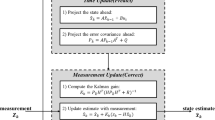Abstract
In recent days, accurate localization becomes essential for enabling smartphone-based navigation to attain maximum accuracy in the construction of the real world.Fingerprint-based localization is the widespread solution to achieve and assure effective performance. In this study, a new fingerprint-based localization model using a bat algorithm (BA) is presented stimulated by the echolocation nature of microbats. The presented model adapts BA for estimating the location information. Initially, the presented model applies a Bayesian-rule based objective function. Then, the BA is used for improving the accuracy and analyzing the effects of the initial position of the bats on the localization outcome. For mitigating the estimation error, the Kalman filter is employed for updating the initially determined position using the BA for tracking purposes. The experimental analysis indicated an improvement in real-time performance and decrease in computation complexity. The presented model also obtained maximum localization accuracy with minimum localization error over the compared methods.






Similar content being viewed by others
References
Atia MM, Noureldin A, Korenberg MJ (2013) Dynamic online- calibrated radio maps for indoor positioning in wireless local area networks. IEEE Trans Mob Comput 12(9):1774–1787
Au AWS, Feng C, Valaee S, Reyes S, Sorour S, Markowitz SN, Gold D, Gordon K, Eizenman M (2012) Indoor tracking and navigation using received signal strength and compressive sensing on a mobile device. IEEE Trans Mob Comput 12(10):2050–2062
Bahl P, Padmanabhan V (2000) Radar: An in-building rf- based user location and tracking system. In: Proceedings of the IEEE Conference on Computer Communications, pp 775–784
Ding G, Tan Z, Wu J, Zhang J (2014) Efficient indoor fingerprint- ing localization technique using regional propagation model. IEICE Trans Commun E97-B(8):1728–1741
Ding G, Tan Z, Wu J, Zeng J, Zhang L (2015) Indoor fingerprinting localization and tracking system using particle swarm optimization and Kalman filter. IEICE Trans Commun 98(3):502–514
Feng C, Au W, Valaee S, Tan Z (2012) Received signal strength based indoor positioning using compressing sensing. IEEE Trans Mob Comput 11(12):1983–1993
Guo X, Zhang D, Wu K, Ni L (2013) Modloc: Localizing mul- tiple objects in dynamic indoor environment. IEEE Trans Parallel Distrib Syst PP,(99):1–11
Jadad HA, Touzene A, Day K, Alziedi N, Arafeh B (2019) Context-aware prediction model for offloading mobile application tasks to mobile cloud environments. Int J Cloud Appl Comput (IJCAC) 9(3):58–74
Jadad HA, Touzene A, Day K (2020) Offloading as a service middleware for mobile cloud apps. Int J Cloud Appl Comput (IJCAC) 10(2):36–55
Laoudias C, Kemppi P, Panayiotou C (2009) Localization using radial basis function networks and signal strength fingerprints in wlan. IEEE Global Communications Conference (GLOBECOM), pp 1–6
Lee K, Choi HO, Min SD, Lee J, Gupta BB, Nam Y (2017) A comparative evaluation of atrial fibrillation detection methods in Koreans based on optical recordings using a smartphone. IEEE Access 5:11437–11443
Li Y, Xue F, Feng L, Qu Z (2017) A driving behavior detection system based on a smartphone’s built-in sensor. Int J Commun Syst 30(8):.e3178
Li Y, Xue F, Fan X, Qu Z, Zhou G (2018) Pedestrian walking safety system based on smartphone built-in sensors. IET Commun 12(6):751–758
Li Y, Peng X, Zhou G, Zhao H (2020) SmartJump: a continuous jump detection framework on smartphones. IEEE Internet Comput 24(2):18–26
Liu H, Darabi H, Banerjee P, Liu J (2007) Survey of wireless in- door positioning techniques and systems. IEEE Trans Syst Man Cybern Part C Appl Rev 37(6):1067–1080
Murata M, Ahmetovic D, Sato D, Takagi H, Kitani KM, Asakawa C (2018) Smartphone-based indoor localization for blind navigation across building complexes. 2018 IEEE International Conference on Pervasive Computing and Communications (PerCom). Piscataway, IEEE, pp 1–10
Rastogi S, Bhushan K, Gupta BB (2016) Android applications repackaging detection techniques for smartphone devices. Procedia Comput Sci 78(C):26–32
Steiniger S, Neun M, Edwardes A (2012) Foundations of location based services. Technical Report, Cartography for Swiss Higher Education
Honkavirta V, Perala T, Ali-loytty S, Piche R (2009) Acomparative survey of wlan location fingerprinting methods. Workshop on Positioning, Navigation and Communication (WPNC’09), pp 243–251
Wu K, Xiao J, Yi Y, Chen D, Luo X, Ni L (2013) Csi-based in- door localization. IEEE Trans Parallel Distrib Syst 24(7):1300–1309
Xu L, Wan P, Wang Y, Liang T (2019) A similarity algorithm based on hamming distance used to detect malicious users in cooperative spectrum sensing. Int J High Perform Comput Networking 14(1):112–119
Yang XS (2010) A new metaheuristic bat-inspired algorithm. In: Nature inspired cooperative strategies for optimization (NICSO 2010). Springer, Berlin, pp 65–74
Yin J, Yang Q, Ni L (2005) Adaptive temporal radio maps for indoor location estimation. IEEE International Conference on Pervasive Computing and Communications (PerCom), pp 85–94
Author information
Authors and Affiliations
Corresponding author
Additional information
Publisher’s note
Springer Nature remains neutral with regard to jurisdictional claims in published maps and institutional affiliations.
Rights and permissions
About this article
Cite this article
Gobi, R. Smartphone based indoor localization and tracking model using bat algorithm and Kalman filter. Multimed Tools Appl 80, 15377–15390 (2021). https://doi.org/10.1007/s11042-020-10438-y
Received:
Revised:
Accepted:
Published:
Issue Date:
DOI: https://doi.org/10.1007/s11042-020-10438-y




